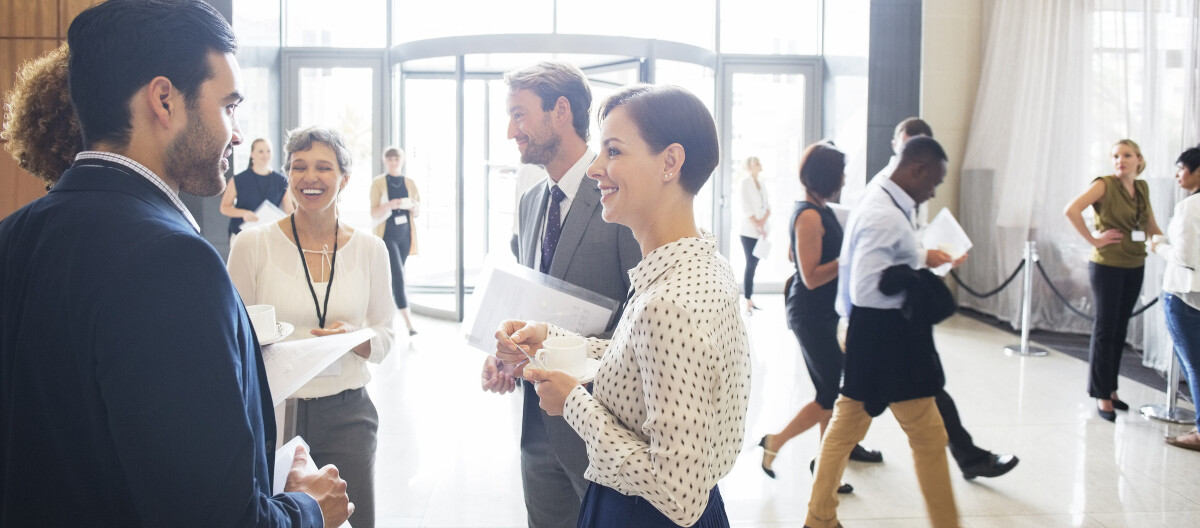B2B trade fairs: maximum opportunities for lead generation
Trade fairs are good networking opportunities for consolidating existing business partnerships and attracting new customers. Both are more challenging in the B2B sector than at exhibitions for private consumers. This is down to the type of visitors: professionals are much more focused and critical but, above all, interested in specific information about goods and services. Visitors will also include many decision-makers, who usually take a very focused approach to trade fairs.
As an exhibitor, you have to meet their needs in several ways. You need a good concept, with compelling content presented in an attractive way. Afterwards, you must analyse the experience and keep in touch with the most promising and valuable leads.
Trade fair preparation: how it works
You need to begin preparing a solid offer and marketing strategy months ahead of the event. The following tips show what good trade fair preparation could look like.
- The right audience is key to success. So, mark relevant events in the trade fair calendar as early as possible. You should think about previous experiences when making your decision. This is obviously only possible for events you are familiar with. But other events can also offer interesting opportunities. You should take a fresh look at and revaluate your trade fair presence every year.
- A trade fair should ideally end up bringing in more than it costs. So, after choosing which trade fairs to attend, you need a well-calculated budget. There are numerous factors to consider, including renting event space, as well as the cost of marketing materials and travel and accommodation.
- Specific goals can help to determine your budget. Decide whether your aim is to generate leads, increase brand awareness or boost sales. It's good to set specific and measurable goals. This will help later on with trade fair follow-up.
- The next step is your marketing strategy. This should clarify things like which products or services you want to focus on at the trade fair and which advertising media and channels you will use. During your trade fair preparation, you also need to think about how you can highlight the brand and its USPs.
- Stand staff are an important factor for a successful trade fair. They act as an advertisement for the company. How well this works also depends on what you’re hoping to achieve. For example, if you want to generate more leads, you need experienced and inspiring sales professionals. But if your focus is on presenting technologies, employees must be able to present the relevant functions comprehensibly and be able to solve technical problems quickly. Remember: stand staff must conscientiously take note of any interested parties, possible contacts (on analogue or digital lead sheets) and the outcome of meetings.
- Now you need to choose the right location for your presentation. Depending on what you are offering and your target group, this could be a quiet corner or a place with a lot of visitor traffic. The location must also align with your marketing strategy, for example options for interactive experiences or visual presentations like videos.
- Once you have sorted the location and type of presentation, you must brief and prepare the staff who are going to be at the exhibition. This should cover achieving the goals you have set and appropriate conduct during the trade fair.
- It’s worth digitizing your trade fair appearance. You could announce your attendance in advance through the social media channels used by your target group. Make sure you include important information such as stand number or a map of the exhibition centre. You can also use social media to share trade fair offers, such as discounts, prize draws, advertising materials, videos and brochures. The point of contact can be the company's own landing page, which is set up just for the trade fair.
Present your company on our platform!
The advantages:
- International audience and visibility
- Set-up in 5 minutes
- Numerous options and services through individual content
Trade fair follow-up: how it works
You will only know whether your B2B trade fair attendance was successful after the event. That’s why good trade fair follow-up is important. You need to be quick. Gain the advantage by reflecting on the trade fair faster than your competitors and by responding equally quickly to what you find.
- You need to sift through and categorise leads the day after the trade fair. Decide who is going to receive a quick thank-you email for visiting your stand. This is the first step in follow-up correspondence. It is partly aimed at making personal contact – for example, as part of a nurturing email campaign.
- Compare the leads collected with the master data system and check them for issues such as duplicate or outdated information.
- Refer any particularly promising customers or interested parties to the sales department for individual exchange (with specific offers if necessary).
- The next phase of the trade fair follow-up focuses on how effective the event was. Digital tools are best for this. They enable quick and comprehensive analysis of success based on the goals you set. The aim is to determine which measures worked well and which did not. Analysis could include social media engagement and the number of inquiries or deals. Based on the analysis, decide whether to retain, get rid of or optimise individual activities.
Conclusion
Trade fairs are still a great way to establish and strengthen a brand. Depending on your approach, they can increase sales or extend reach. Trade fair appearances should be strategically planned months in advance, allocated a sufficient budget and, most important, analysed afterwards.
Digital tools are increasingly important for trade fair preparation and follow-up. They provide support with planning, implementation, identifying goals and subsequent assessment of success. Stand staff on site are also key factors for success.

